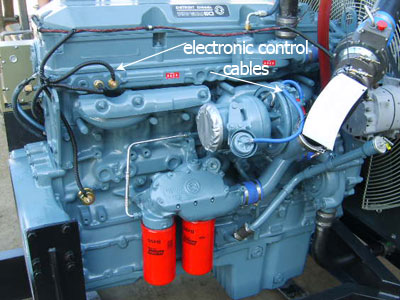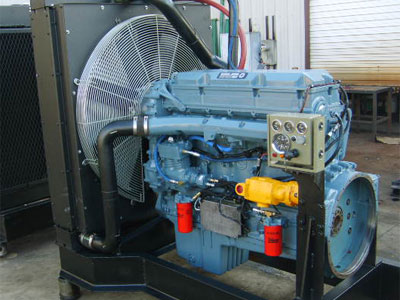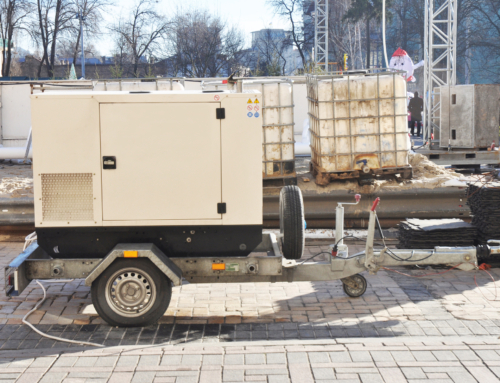The Detroit Diesel series 60 has been providing power since 1987. Despite its popularity that remains today, many people do not know a thing about this excellent piece of machinery. If you are lucky enough to own a Detroit Diesel series 60, or if you are thinking about purchasing one, understanding the ins and outs of the engine could help you to determine whether it’s running as it should. Learning more about this great engine will also help you to appreciate it for the fantastic piece of tech that it is. All true motor enthusiasts will know a thing or two about their engine! This article will guide you through everything you need to know about the Detroit Diesel series 60.

Table of Contents
What is the Detroit Diesel series 60?
The Detroit Diesel series 60 is a four-stroke inline diesel engine that was first produced in 1987. When it first appeared, motorists were quick to notice that this exciting engine differed from most high-way acceptable motor engines through using an overhead camshaft and drive-by-wire electronic controls.
The Detroit Diesel series 60 is most widely used in the bus industry and is used to power larger vehicles that require more fuel. When it was first introduced, the series 60 became the very first heavy-duty diesel engine to include fully integrated electronic controls, making it easier than ever to power a larger vehicle.
Originally, an 11.1L and 12.7L version of the engine was available however, the 11.1L version of serie 60 became discontinued, leaving the 12.7L to become the go-to for many large vehicles. IN 2001, a 14.0L series 60 was developed but later, in 2011, all series 60 engines were discontinued and replaced by DD15 engines.
What was the Detroit Diesel series 60 used for?
The Detroit Diesel series 60 was designed to fuel the heavy-duty vehicle market and was a more efficient option than many existing engines at the time. In the 80’s the engine became very popular for city bus systems- many modern city bus systems are still powered by this engine today.
The smallest series of 60 engines, the 11.1L, was used for smaller buses because of its fuel efficiency and electronic control capabilities. The larger sizes, the 12.7L, and the 14.0L were also used in buses along with large Freightliner trucks. The larger sizes were ideal for these bigger vehicles because they offered higher horsepower.
Pros and Cons of the Detroit Diesel series 60
Despite being favored as one of the best heavy-duty engines, the Detroit Diesel 60 had recently been discontinued and replaced by the DD15 engine. Motor enthusiasts will always differ in their opinion of the 60 series due to its many pros and cons.
Detroit Diesel series 60 pros

The series 60 was once ranked the second-best diesel engine ever in the ‘Best diesel engine ever’ list. The engine’s renowned popularity is mainly due to the benefits that this exciting piece of machinery offered at its time of release.
Electrical controls
The Detroit Diesel Electronic Control system (DDEC) was a feature of the engine that made it incredibly popular for city busses. The DDEC system was the first of its kind to be used on a highway engine and remained the only one available for many years.
The DDEC offered a range of excellent functions including:
- Engine diagnostics
- Shutdown timers
- Progressive-shift functions
- Fault history
- Speed limiting
- Automatic stall-prevention
- Cruise control
The system also allowed the vehicle owner to download engine management reports, which hugely assisted engine maintenance and repair. With these reports, owners could increase their productivity, reduce engine abuse and also decrease fuel consumption.
Detroit Diesel series 60 problems
While the engine is still favored by diesel lovers today, it did not come without its faults. The series 60 experienced a number of problems that eventually sent it out of the production line.
Cold starts
Detroit Diesel series 60 engines struggled to start in colder temperatures, which caused problems for bus services. The issue can be dealt with by using a good starting fluid and once the engine is running, it shouldn’t bring up any more problems.
Throttle problems
For vehicles with certain types of engine brakes installed, the series 60 may cause you to experience problems with your throttle. If throttle problems are something that you regularly experience, you may need to invest in engine breaks that have different programming.
Bearing problems
Older models of the Series 60 can be prone to bearing issues. These problems are mainly caused by low pressure at idle. When there is a lack of lubrication or overheating, the bearing in your engine can seize, which could create a number of problems in your engine. If you have a Detroit series 60 engine, it is a good idea to keep an eye on the bearings and ensure that they have adequate lubrication.
Poor fuel economy
Many people complain about the fuel economy of the series 60, especially the 14.0L model. The Detroit Diesel series 60 engines were designed for maximum horsepower so naturally, fuel usage increased as well. Some enthusiasts will claim that the poor fuel economy of the 60 series is due to poor operating practices, such as running the engine at high RPM for long periods of time.
What is the difference between Detroit Diesel Series 60 Engines 12.7litre and 14litre?
The primary difference between the 12.7litre and 14litre versions of the Detroit Diesel Series engines is the variation in power output and size. While the former, also called Series 60 12.7L boasts of a simpler displacement, the later, also called the Series 60 14L has a larger one. The size difference impacts both the performance and the power output of the engine. Clearly, the 14L engine is the best choice when it comes to a higher power requirement compared to its 12.7L counterpart. In fact, higher power in this case also implies improved acceleration and improved end performance.
Note that it is also important to understand that the specific features, performance and power output can undoubtedly vary based on the application and tuning of the engine. Moreover, the fuel consumption of 14L variant will also be higher compared to the 12.7L engine. Overall, the final choice will be based on the requirements and ultimate goals of an equipment or vehicle where the installation will be done.
Common questions from business owners
How much horsepower does a Detroit Diesel series 60 have?
Detroit engines are designed to have high horsepower so that they can be used to power heavy duty vehicles. The power output of a 60 series can be anywhere between 330bhp and 605bhp, depending on engine size.
Is the Detroit Diesel series 60 a good engine?
The Detroit Diesel 60 series has been ranked as the second-best engine for heavy-duty vehicles and was incredibly popular during the ’80s and ’90s. Although this engine is no longer produced, many vehicles still used Detroit engines, particularly city busses and large trucks. The Detroit Diesel 60 is a good engine for large vehicles but the problems surrounding the engines cannot be ignored.
How can I get more horsepower out of my Detroit Diesel series 60?
To increase the horsepower of your 60 series, install a high flow muffler, which will allow air to flow out of the engine freely. You could also invest in a ported exhaust manifold which has the potential to increase your engine horsepower by 35 percent!
What are some pros and cons of using a Detroit diesel series 60 engine?
The Detroit diesel series 60 engine has been ranked second-best in the ‘best engine list’ due to its excellent functionalities of speed limiting, cruise control, engine diagnostics, etc. However, it has also been criticized by some users for its poor fuel economy.
How to solve Detroit diesel series 60 failure with cold starts?
Yes, it can be difficult to cold start Detroit diesel series 60. One way to solve this issue is to regularly change the SRS and TRS sensors. However, keep in mind that both sensors should be replaced at the same time. It is also recommended to periodically maintain the cooling system to solve this issue.
What is the weight of the Detroit diesel series 60 engine?
The approximate weight of the Detroit diesel series 60 engine is 1199 kg.
How many versions does the Detroit diesel series 60 engine have?
The Detroit diesel series 60 engine is available in three versions, 11.1 liter, 12.7 liter, and 14.0 liter.
How many cylinders does the Detroit diesel series 60 engine have?
The Detroit diesel series 60 engine has six cylinders in total.
What can be the reason for white smoke coming out of the Detroit diesel series 60 engine?
Some probable reasons for white smoke coming out of the Detroit diesel series 60 engine include a broken piston ring, defective injector, prolonged idle time, or bent push rods caused by engine overheating.
What are the conditions causing the ‘stop engine’ light to turn on for the Detroit diesel series 60 engine?
The ‘stop engine’ light is turned on due to loss of coolant, high oil temperature, low oil pressure, and auxiliary shutdown.
Does the Detroit diesel series 60 engine have an idle shutdown system?
Yes, the Detroit diesel series 60 engine has an idle shutdown system. The is activated when the vehicle is in neutral and the engine is in idle mode. This system allows fuel conversion by eliminating excessive idling.
What is the difference between The Detroit diesel series 60 engine 12.7-liter and 14.0-liter versions?
The 12.7 liter Detroit diesel series 60 engine has an 18-valve cylinder head, whereas the 14.0 liter Detroit diesel series 60 engine has a 24-valve cylinder head.
What are some disadvantages of the Detroit diesel series 60 engine?
Some disadvantages of the Detroit diesel series 60 engine are throttle problems, defective wrist pins, cold starts, EGR problems, and fuel economy.







Leave A Comment